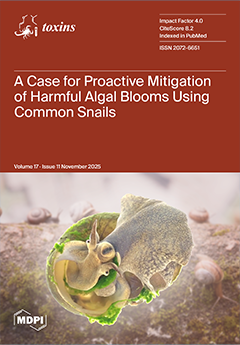In China, bites caused by the
Naja atra and
Deinagkistrodona acutus are the most common types of snakebites. While the functional characteristics of the two venom components have been well documented, their in vivo metabolic pathways, target organ distribution patterns, and dynamic pharmacokinetic
[...] Read more.
In China, bites caused by the
Naja atra and
Deinagkistrodona acutus are the most common types of snakebites. While the functional characteristics of the two venom components have been well documented, their in vivo metabolic pathways, target organ distribution patterns, and dynamic pharmacokinetic profiles remain less explored. This study established a murine envenoming model through CY7-SE labeling of
Naja atra and
Deinagkistrodon acutus venoms. The real-time in vivo absorption and biodistribution of venoms were dynamically monitored via fluorescence imaging, with subsequent proteomic profiling to characterize organ-specific toxin targeting patterns. Gel filtration chromatography and HPLC analyses validated labeling efficiency at ratios of 0.1 mg CY7-SE per 1 mg
Naja atra venom and 0.075 mg CY7-SE per 1 mg
Deinagkistrodon acutus venom, with electrophoretic confirmation of protein integrity and preserved 740 nm fluorescence excitation. Acute toxicity assays demonstrated no significant difference in LD
50 lethality between labeled and native venoms (
p > 0.05). The intoxication models revealed species-specific pathophenotypes, i.e., CY7-
Naja atra venom induced systemic weakness, tachypnea, and inflammatory necrosis in lung, myocardium, and liver, whereas CY7-
Deinagkistrodon acutus venom provoked hemorrhagic diathesis. Both models exhibited marked leukocytosis, transaminitis, and elevated creatinine levels (
p < 0.05). Fluorescence tracing uncovered distinct biodistribution kinetics:
Deinagkistrodon acutus venom achieved peak organ accumulation at 3 h with rapid dissemination (24 h injection-site retention: 12.61%), contrasting with
Naja atra venom’s delayed 6 h peak and prolonged renal sequestration (24 h injection-site retention: 60.9%). Target organ proteomic profiling identified
Deinagkistrodon acutus-enriched thrombin-like enzymes and metalloproteinases in lung/liver/spleen, while
Naja atra venom predominantly accumulated renal acidic phospholipase A
2 and weakly neurotoxic NNAM2.
Full article






